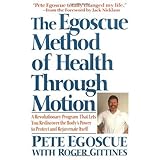
Average Reviews:

(More customer reviews)There are now (2006) four books by Pete Egoscue available: (1) "The Egoscue Method of Health Through Motion" (1992), (2) "Pain Free" (1998), (3) "Pain Free at your PC" (1999) and (4) "Pain Free for Women" (2002). If you are suffering from musculoskeletal pain and someone has recommended Egoscue to you or you are impressed with the testimonials in the Amazon reviews, you may well ask yourself, "Which book should I buy first?" Probably the second, "Pain Free" but each has its merits.
All the books are based on two generally recognized propositions: (1) in a healthy human the lines connecting the two ankles or the two knees or the two hips or the two shoulders should all be horizontal and the feet and knees should point straight forward when walking or standing without thinking about one's posture, and (2) deviations from this structure usually originate with the position of the pelvis. Trying to correct the manifestation of the misaligned pelvis will not help until the fundamental problem is fixed.
In the first book, Egoscue describes a self-diagnosis which puts you in one of four categories based largely on your posture when standing in a natural, relaxed way. Once you know your category, you turn to page 127 to find your menu of exercises. The exercises are presented in alphabetical order; you look up the exercises on your menu, learn and do them. You may need as much as 90 minutes a day or as little as 30, depending on the severity of your condition.
Of the first book, Egoscue says in the second (page 282) "[It was] a pretty ambitious theme. This one, 'Pain Free,' is more more modest." I think that means that the reader had to work harder to understand the first than the second. People in pain do not immediately know which category they fall into. But they do know where they hurt. So "Pain Free", after a brief explanation of the fundamental theory, is organized by where the pain is: feet, ankles, knees, hips, back, shoulders, arms, and neck and head. For each area, Egoscue gives exercises. Many exercises are used for more than one area, but everywhere the exercise is used, a picture of the exercise is repeated and the page number where is was described in full is given. The result is definitely easier to use. Also, there are a number of new exercises for specific problems, such as a herniated disk in the spine. Initially, your program of exercises may require 90 minutes or more, but most of the time is spent on one particular exercise. Once pain is gone for a week or more, the maintenance exercises (pages 277-282) should not take more than about 20 minutes a day.
The third book, "Pain Free at your PC" is aimed, obviously, at PC users. Egoscue distinguishes three categories, but if you use a PC more than about an hour a day, you are in the third category. Initially, you'll need 80 minutes a day at home and 5 minutes at the office, but most of that 80 minutes is on one exercise, the supine groin stretch, and the time needed for it will diminish. If you are a "power user" of the PC, you are at serious risk of developing musculoskeletal pain, not because of any problem with your PC or your chair or your desk, but because, for hours at a time, you are not moving the main muscles that hold body together and make it work. They atrophy, and problems develop. Egoscue's exercises are designed to cure or avoid those problems. If you are a heavy PC user, you could start with this one.
I have not read "Pain Free for Women" since I was clearly not in its target audience. It would be a mistake, however, for women to conclude that since this book is specifically for them the other books don't apply. Every word of the other books applies equally to men and women. This one, however, has chapters on pregnancy, childbirth, and other specifically feminine matters. For herniated disks, aching feet, and other problems common to both sexes, I would suggest "Pain Free" first.
The Egoscue book that I want to read is the one that has not been written, the one that explains Egoscue's own thinking, what each exercise does and why certain exercises should be done before others. On these questions, all the books are silent and rather dogmatic. The reader is supposed to know what the "hip flexors" are but is presumed unable to understand why one exercise should precede others. Egoscue, however, rearranges them in numerous orders. What does he know that he doesn't tell? Because of that problem, I have given the books only four stars.
Click Here to see more reviews about: The Egoscue Method of Health Through Motion: Revolutionary Program That Lets You Rediscover the Body's Power to Rejuvenate It

0 comments:
Post a Comment